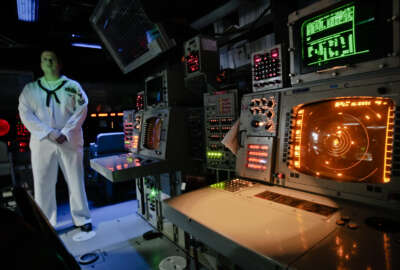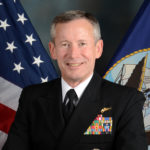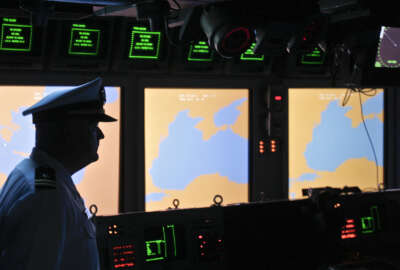
Navy establishes task force on cyber interoperability
The Navy has formed a temporary organization to gather information and investigate a path toward interoperability and integration for its systems.

The Navy has formed a temporary organization to gather information and investigate a path toward interoperability for its systems.
“What we’ve done just recently — it’s very new — is stood up a task force,” Vice Adm. Ted Branch told Federal News Radio during the Naval Sea Air Space expo at the Gaylord National Convention Center in National Harbor, Maryland on May 18. “It’s being led by … [Director of Integrated Fires for the Deputy Chief of Naval Operations for Information Warfare Margaret] Palmieri, who’s gathering experts from across the domain to talk about what the drivers are that will drive data standards and make everything talk to everything else.”
Branch said that there have been various isolated attempts at “integration and interoperability of systems to weapons to sensors to platforms” before, but they were never collective, coordinated efforts, and never had much reach. This effort is different.
“There are a lot of silos of excellence in the different programs in the different warfare areas, and all those people are coming into this team to work their piece of the puzzle,” Branch said.
Branch said the eventual, theoretical goal of this effort would be for any weapon to be able to be targeted by data from any sensor, and for network nodes to automatically share information with each other. But that’s a long way off, and the Navy is just getting started.
“That’s a big reach from where we are right now, but that’s where we’re trying to go in terms of architecture and standards and specifications,” Branch said. “The task force has four months to report out on where we need to go as a way ahead, and they started their work this week. We’ll see where they go in four months and what the logical next steps are. I wouldn’t be surprised if there was some kind of organization set up among the systems commands and acquisition authorities to continue this path into the future.”
This would follow the pattern of the last task force set up by the Navy’s information warfare division, Task Force Cyber Awakening, which is now called Navy Cybersecurity. TFCA was created in 2014 for a similar reason: to take a number of disjointed efforts across various programs, and bring them together into a single, focused effort. Branch said that after addressing the immediate concerns, the group’s mission has evolved to become more about standards and specifications, and “designing in cybersecurity instead of bolting it on after the fact.”
“What we’re really talking about is warfare in the information age,” Branch said. “We’re elevating information as a warfighting domain that is analogous to undersea, surface, space warfare, and in fact, our position is that if we don’t get it right in the information domain, which includes electromagnetic spectrum maneuver warfare and cyber, if we don’t get it right there, then what we do in those other domains —aviation, surface, undersea —probably won’t matter, because the fight will be lost before it’s ever joined.”
Copyright © 2025 Federal News Network. All rights reserved. This website is not intended for users located within the European Economic Area.
Daisy Thornton is Federal News Network’s digital managing editor. In addition to her editing responsibilities, she covers federal management, workforce and technology issues. She is also the commentary editor; email her your letters to the editor and pitches for contributed bylines.
Follow @dthorntonWFED




